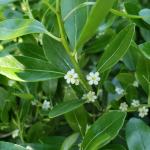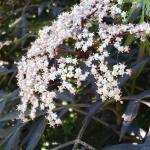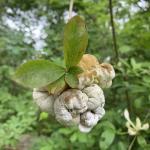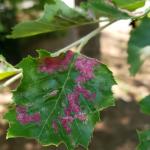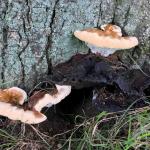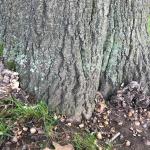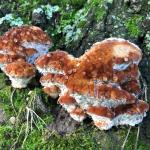UMass Extension's Landscape Message is an educational newsletter intended to inform and guide Massachusetts Green Industry professionals in the management of our collective landscape. Detailed reports from scouts and Extension specialists on growing conditions, pest activity, and cultural practices for the management of woody ornamentals, trees, and turf are regular features. The following issue has been updated to provide timely management information and the latest regional news and environmental data.
To read individual sections of the message, click on the section headings below to expand the content:
Scouting Information by Region
Environmental Data
The following data was collected on or about June 26, 2019. Total accumulated growing degree days (GDD) represent the heating units above a 50° F baseline temperature collected via our instruments for the 2019 calendar year. This information is intended for use as a guide for monitoring the developmental stages of pests in your location and planning management strategies accordingly.
|
MA Region/Location |
GDD |
Soil Temp |
Precipitation |
Time/Date of Readings |
||
|
1-Week Gain |
2019 Total |
Sun |
Shade |
|||
|
CAPE |
114 |
567 |
65 |
69 |
2.50 |
6:00 AM 6/26 |
|
SOUTHEAST |
129 |
649.5 |
67 |
63 |
1.80 |
12:35 PM 6/26 |
|
NORTH SHORE |
117.5 |
635.5 |
65 |
50 |
1.08 |
9:30 AM 6/26 |
|
EAST |
129.5 |
715 |
73 |
67 |
1.77 |
5:00 PM 6/26 |
|
METRO |
125 |
664 |
65 |
62 |
1.49 |
5:30 AM 6/26 |
|
CENTRAL |
123.5 |
695 |
71 |
60 |
1.43 |
2:00 PM 6/26 |
|
PIONEER VALLEY |
130 |
720 |
71 |
66 |
1.10 |
10:30 AM 6/27 |
|
BERKSHIRES |
124.5 |
636.5 |
67 |
62 |
1.47 |
8:30 AM 6/26 |
|
AVERAGE |
124 |
660 |
68 |
62 |
1.58 |
- |
n/a = information not available
Phenology
| Indicator Plants - Stages of Flowering (BEGIN, BEGIN/FULL, FULL, FULL/END, END) | ||||||||
|---|---|---|---|---|---|---|---|---|
| PLANT NAME (Botanic/ Common) | CAPE | S.E. | N.S. | EAST | METRO W. | CENT. | P.V. | BERK. |
|
Itea virginica (Virginia sweetspire) |
Begin |
Begin |
* |
* |
* |
Begin |
Begin |
Begin |
|
Rhus typhina (staghorn sumac) |
Begin |
Begin |
Begin |
Begin |
Begin |
* |
Begin |
Begin |
|
Hydrangea arborescens (smooth Hydrangea) |
Begin |
Begin/Full |
Full |
* |
Begin |
Begin |
Full |
Begin |
|
Sambucus canadensis (American elderberry) |
Begin |
Full |
Begin |
Full |
Begin |
Full |
Full |
Full |
|
Ligustrum spp. (privet) |
Begin/Full |
Full |
Full |
Full |
Full |
Full |
Full |
Full |
|
Catalpa speciosa (northern Catalpa) |
Begin/Full |
Full |
Full |
Full |
Full |
Full |
Full |
Full |
|
Hydrangea anomala petiolaris (climbing Hydrangea) |
Begin/Full |
Full |
Begin/Full |
End |
* |
End |
End |
Full |
|
Cotinus coggygria (common smokebush) |
Full/End |
Full |
Full |
Full |
Full/End |
Full |
Full |
Full |
|
Syringa reticulata (Japanese tree lilac) |
Full/End |
Full |
Full/End |
Full/End |
Full |
Full |
Full/End |
Full |
|
Kalmia latifolia (mountain laurel) |
Full/End |
Full/End |
Full |
Full |
Full |
Full/End |
Full/End |
Full |
|
Philadelphus spp. (mockorange) |
Full/End |
Full/End |
Full/End |
End |
Full |
End |
Full/End |
Full/End |
| * = no activity to report/information not available | ||||||||
Regional Notes
Cape Cod Region (Barnstable)
General Conditions: The average temperature over the period from June 19 – June 26 was 65˚F with a low of 55˚F on June 22 and a high of 84˚F on June 23. The period was dominated by high humidity except for June 23 and 24 which had relatively low humidity for this time of year. Rain occurred on several days totaling 2.5 inches, the most significant amounts came on June 21 and June 25. On the afternoon of June 22, hail occurred in many parts of the upper Cape. The precipitation has kept topsoil and subsoil moisture conditions adequate for this time of year and supplemental irrigation for the most part has not been necessary.
Pests/Problems: Lecanium scale which is widespread in the area on oak is still in the adult and/or egg stage, no crawlers have been observed yet. The crawler stage is the next possible stage for management. Other insects or insect damage observed over the period include the following: more than the usual damage by rose slug sawfly (make sure larvae are present before treating because most have migrated to the soil to pupate), Hibiscus sawfly damage by active larvae, four lined plant bug damage on Liatris, and azalea lace bug on PJM Rhododendron. Asiatic garden beetle has begun emerging. Earwigs are active and causing damage on plants. Disease symptoms and signs seen over the period include spot anthracnose on dogwood, black spot on rose (worse than normal – lots of defoliation), boxwood blight on boxwood, powdery mildew on Monarda, powdery mildew on ninebark, many sycamores still remain denuded of leaves as a result of sycamore anthracnose, downy mildew on Cleome, and red thread in turf. Weeds in bloom include black medic (Medicago lupulina), white clover (Trifolium repens), fleabane (Erigeron annuus), black swallowort (Cynanchum louiseae) and narrowleaf plantain (Plantago lanceolate). Mosquitos, ticks and bunnies abound.
Southeast Region (New Bedford)
There are no regional notes this week.
Attention Southeast region readers: Would you be a good scout for the Landscape Message? UMass Extension is seeking a capable individual to take over reporting duties for the Southeast region starting ASAP. Candidates must be able to scout and report weekly through June, bi-weekly through July, August, and September, and monthly in October, November, and December. Ideally this person would be located in roughly the Brockton-Bridgewater-Taunton area (or able to regularly scout that area), although we will entertain inquiries from throughout Bristol and Plymouth Counties. The scouting and reporting for each message is estimated to take approximately 1/2 day per message week, and UMass Extension is able to pay a stipend for scouts. If interested, see the "Description of Responsibilities" here: https://ag.umass.edu/sites/ag.umass.edu/files/content-files/alerts-messages/2018_scout_expectations.pdf then contact Ellen Weeks at weeks@umass.edu or 413-545-2685 to apply.
North Shore (Beverly)
General Conditions: During this reporting period, temperatures were in the low to high 70s during the day. Temperatures above 80 degrees were recorded only on one day – Sunday, June 23. Night temperatures were in the mid-50s to low 60s. We had both sunny days and overcast days with rain showers occurring on three days. Approximately 1.08 inches of rain were recorded at Long Hill during this period. Plants in the landscape are lush and green due to the rains in the last few weeks. Woody plants seen in bloom include: tulip tree (Liriodendron tulipifera), Japanese tree lilac (Syringa reticulata), Peking tree lilac (Syringa pekinensis), Stewartia (Stewartia rostrata), privet (Ligustrum spp.), kousa dogwood (Cornus kousa), mountain laurel (Kalmia latifolia), smoke bush (Cotinus coggygria), sweet azalea (Rhododendron arborescens), magician Deutzia (Deutzia magicien), Japanese Hydrangea vine (Schizophragma hydrangeoides) and Indigofera (Indigofera amblyantha). Herbaceous plants in bloom include: Virginia rose (Rosa virginiana), summer flowering roses (Rosa spp.), yellow Corydalis (Corydalis lutea), foxglove (Digitalis purpurea), Clematis vines (Clematis paniculata), spiderwort (Tradescantia spp.), bush cinquefoil (Potentilla fruticosa), feverfew daisy (Chrysanthemum parthenium), Persicaria or giant fleeceflower (Persicaria polymorpha), fragrant water lily (Nymphaea odorata), and ox-eye daisy (Leucanthemum vulgare).
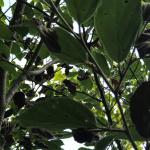 Pests/Problems: Phyllosticta leaf blotch was observed on witchhazel (Hamamelis intermedia). Not surprising since the rains and frequent cloud cover over the last several weeks make plants more susceptible to leaf diseases. Pruning the witchhazel to improve air circulation can help reduce the incidence of the disease. If you notice this in your landscape, consider sending a sample to the Umass Extension Plant Diagnostic Lab (https://ag.umass.edu/services/plant-diagnostics-laboratory) for diagnosis of the problem. Lily leaf beetle and slug damage were also observed. Weeds are growing vigorously due to the rains in the last few weeks. Take measures to control weeds before they set seed. Goutweed (Aegopodium podagraria), an invasive weed, is in full bloom and is flourishing in the landscape. Oriental bittersweet (Celastrus orbiculatus), another invasive plant, is also growing vigorously in the landscape. Mosquitoes are numerous and very active. Ticks are also active so protect yourself with insect repellent when working outdoors.
Pests/Problems: Phyllosticta leaf blotch was observed on witchhazel (Hamamelis intermedia). Not surprising since the rains and frequent cloud cover over the last several weeks make plants more susceptible to leaf diseases. Pruning the witchhazel to improve air circulation can help reduce the incidence of the disease. If you notice this in your landscape, consider sending a sample to the Umass Extension Plant Diagnostic Lab (https://ag.umass.edu/services/plant-diagnostics-laboratory) for diagnosis of the problem. Lily leaf beetle and slug damage were also observed. Weeds are growing vigorously due to the rains in the last few weeks. Take measures to control weeds before they set seed. Goutweed (Aegopodium podagraria), an invasive weed, is in full bloom and is flourishing in the landscape. Oriental bittersweet (Celastrus orbiculatus), another invasive plant, is also growing vigorously in the landscape. Mosquitoes are numerous and very active. Ticks are also active so protect yourself with insect repellent when working outdoors.
East Region (Boston)
General Conditions: The first week of summer brought pleasant weather conditions. High temperatures averaged 79˚F, reaching a high of 85˚F on both June 23 and 24. The remainder of the days were in the 70’s. Low temperatures ranged from 57- 65˚F, averaging 59.4˚F. We received rain on three days totaling 1.77” with the majority, 1.15”, falling on June 22. We are at 715 GDDs for the year after gaining 129.5 this past week. Plants are thriving, putting on new growth and many are in flower; Cotinus coggygria (smoke bush), Kalmia spp. (mountain laurel), Lavandula angustifolia (lavender), Lonicera sempervirens (coral honeysuckle), Rosa spp., Syringa pekinensis (Peking lilac) and Tilia cordata (littleleaf linden). Catalpa speciosa (Catalpa) are in full bloom and eye catching in mixed woodlands along roadsides. Morus spp. (mulberry) fruit is ripening. A wide variety of sweat bees (Halictids) have been quietly collecting pollen throughout the landscape.
Pests/Problems: The effects of our cool, moist spring continues to appear in plants. Fungal and bacterial leaf diseases are visible throughout the landscape, especially on rosaceous material. The easily identified red milkweed beetle (Tetraopes tetrophthalmus) is actively feeding and mating on milkweed (Asclepias spp.) foliage. Black swallowwort (Cynanchum louiseae) is beginning to flower. Greater celandine (Chelidonium majus) is flowering. A small population of mile-a-minute vine (Persicaria perfoliata) was identified and eliminated in a Boston suburb.
Metro West (Acton)
General Conditions: We welcome this first week of the summer season with a gain of 125 GDD during this recording period and with a total of 1.49” of rain. The historical monthly average rainfall for June is 3.93” and 4.39” of rain has been recorded for this month so far and it’s not over yet! There are 5 days left to the month. The landscape is lush and colorful with all that is in bloom. In some stage of bloom at this time are the following woody plants: Buddleia spp. (butterfly-bush), Catalpa speciosa (northern Catalpa), Cornus kousa (kousa dogwood), C. x rutgersensis 'Ruth Ellen' (Rutgers hybrid dogwood), Cornus sericea (red twig dogwood), Hydrangea arborescens (smooth hydrangea), Ilex glabra (inkberry), I. pedunculosa (longstalk holly), Kalmia latifolia (mountain laurel), Ligustrum spp. (privet), Liriodendron tulipifera (tulip tree), Philadelphus coronarius (sweet mock orange), Potentilla fruiticosa (recently changed to Dasiphora fruticose, shrubby cinquefoil), Rhododendron spp. (Rhododendron/azalea), Rosa spp. (rose), R. rugosa (rose), R. 'Knockout' (knockout family of roses), Rubus spp. (blackberry, bramble, raspberry), Sambucus canadensis (Elderberry), Spirea japonica 'Alpina' (Daphne Spirea), Stewartia pseudocamellia (Japanese Stewartia), Syringa reticulata (Japanese tree lilac), and Tilia cordata (littleleaf linden). Woody vines in bloom are: Clematis spp. (Clematis) and Lonicera sempervirens (trumpet honeysuckle).
Contributing even more color and interest to the landscape are some flowering herbaceous plants including: Achillea millefolium (yarrow), Aegopodium podagraria (Bishop’s weed), Alchemilla mollis (lady’s mantle), Aruncus aethusifolius (dwarf goat's beard), A. dioicus (goat’s beard), Asclepias syriaca (common milkweed), Astilbe spp. (false Spirea), Baptisia australis (false blue indigo), Campanula persicifolia (peach-leafed bell flower), C. takesimana ‘Elizabeth’ (bellflower), Chrysogonum virginianum (green and gold), Clematis recta 'Purpurea' (Clematis), Coreopsis takesimana spp. (tickseed), Dicentra eximia (fringed bleeding heart), Digitalis purpurea (foxglove), Filipendula spp. (meadow sweet), Gaillardia aristata (Indian blanket flower), Geranium cantabrigiense 'Biokovo' and 'Cambridge' (hardy cranesbill), G. macrorrhizum (bigroot geranium), G. sanguineum (bloody cranesbill), G. ‘Johnson’s Blue’ (cranesbill), Hemerocallis fulva (orange daylily), H. 'Stella D'Oro' (daylily), Heuchera spp.(coral bells), Hosta spp. (plantain lily), Lamium maculatum (dead nettle), Iris sibirica (Siberian Iris), I. versicolor (blue flag iris), Leucanthemum spp. (shasta daisy), Lilium spp. (lily), Lupinus' 'Russell Woodfield Hybrids' (lupine), Lychnis coronaria (rose campion), Nepeta spp. (ornamental catmint), Oenothera macrocarpa (Ozark sundrops), Paeonia spp. (peony), Penstemon digitalis 'Husker Red' (beardtongue), Phlox divaricata (Canadian phlox), Primula spp. (primrose), Salvia nemerosa (Salvia), Sedum kamschaticum (Russian stonecrop), Thalictrum spp. (meadow-rue), Thermopsis caroliniana (southern lupine), Tradescantia spp. (spiderwort), Thymus praecox (creeping thyme), and Veronica spp.(speedwell).
Pests/Problems: Soils are saturated and diseases continue to thrive. Anthracnose was observed on sycamore, rust on serviceberry and crabapple, and fall web worm on elm. (See insect section below for more information.) Deer, mosquitoes and ticks are actively feeding.
Central Region (Boylston)
General Conditions: We experienced warmer temperatures this week, but seem to be back to a pattern of rainfall, with five out of seven days featuring measurable precipitation. High temperatures were well into the 80’s for three days, and the first week of summer certainly felt like summer. It is hard to keep up with all that is blooming in the garden at this time of year. Persicaria polymorpha (giant fleeceflower) is a showstopper with nearly seven-foot tall stems and bright white flowers. Catalpa bignonioides (southern Catalpa) is putting on quite a show across the area, with large, fragrant white blossoms. Milkweeds have started to flower. Asclepias syriaca (common milkweed) flowers seem to be the first to open, although a handful of A. tuberosa (butterfly milkweed) have also been observed. Milkweed are the only hosts for monarch caterpillars, the first of which this season were just observed this week as well. Countless herbaceous perennials are in bloom throughout the area, including Penstemon digitalis (beardtongue), Zizia aurea (golden alexanders), Hemerocallis (daylily), Baptisia spp. (false indigo), and Paeonia spp. (peonies). Also coming into bloom are several summer-flowering shrubs, including Itea virginica (Virginia sweetspire) and Hydrangea arborescens (smooth Hydrangea).
Pests/Problems: Slug and snail activity is quite prevalent. Hibiscus sawfly is very active. Also observed were three-lined potato beetle, adult and juvenile cabbage loopers, black leaf spots on many trees, shrubs, and perennials, including anthracnose on Acer saccharum (sugar maple), Kalmia latifolia (mountain laurel), and Phlox paniculata (garden phlox). We still continue to see evidence of winter kill on evergreens. A mature Alaskan cedar (Callitropsis nootkatensis) was the latest to fall victim. A combination of anthracnose and white mold appear to be impacting peonies throughout the garden. Also this week, we experienced a massive die off of gypsy moth caterpillars, thanks to what appears to be both the fungus Entomophaga maimaiga and the NPV virus. (See insect section below for more information.)
Pioneer Valley Region (Amherst)
General Conditions: Summer has officially arrived in the Pioneer Valley and the recent weather has certainly made it feel that way. Temperatures were not especially hot over this past reporting period, but the dew points surged into the upper 60s and lower 70s, peaking on 6/20, creating swampy and muggy conditions. We had a stellar weekend on 6/22 and 6/23 with bright sun, temperatures in the 80s and only minor humidity. Scattered showers passed quickly through the valley on 6/22 from north to south, deviating from our typical west to east pattern. Locally gusty winds also developed with these storms, which interrupted the otherwise beautiful weather. Widespread showers provided the brunt of the week’s moisture on 6/25, with accumulations ranging from only 0.4ʺ in southern Hampden County to >1ʺ in Franklin County. Total precipitation for the month of June is below average in many locations in the valley at this time, with only a few days left until the start of July. Soil moisture is adequate overall and very good in shaded settings and in the northern valley where rain has been more abundant. In the southern valley, soil moisture can be inadequate, especially in sunny and exposed locations. The scattered nature of summer rain highlights the importance of a good rain gauge to know exactly how much rainfall a particular landscape is receiving. A second flush, or continuation of growth, can be observed on several landscape trees and shrubs at this time, such as birch, crabapple, maple, Stewartia, Forsythia, redbud and hemlock, among many others. This is often indicative of good growing conditions. A second flush of shoots and leaves on oak, known as lammas growth, is minimal compared to previous years. Fireflies are now displaying their unique night time spectacle and soon the chorus of nighttime insects will be intensifying.
Pests/Problems: At this time of year it’s important to regularly scout trees and shrubs for various pest and pathogen issues. Close inspection must be performed because many problems are not visible from afar and trees and shrubs with serious problems can look healthy from a distance. June bugs have been observed and Japanese, Oriental and Asiatic garden beetles will be right behind them as we approach the beginning of July. Feeding damage by Japanese beetles can warrant treatment on some landscape trees and shrubs, especially recent transplants. Now that nearly all cultivars of azalea and Rhododendron are done flowering, treatment for lacebugs should take place on badly infested plants. Lacebugs can also be very damaging to Andromeda and damage to serviceberry has also been abundant across the UMass campus over the past few years. Gypsy moth caterpillar mortality has been observed in the Pioneer Valley and elsewhere (see Insect section below), which is great news for areas most hard hit by this destructive, non-native pest. Eastern Hampshire and Hampden Counties in particular have fared the worst in the Tri-County region. We’re now entering the rigorous period of the growing season when new transplants will be tested by heat and potentially dry conditions. Ensure these plants are receiving adequate irrigation to assuage the effects of establishment stress. Arborvitae needle blight continues to be a problem throughout the entire region. Many otherwise healthy trees harbor the two fungi responsible at low levels. Prune and discard any blighted shoots and needles as they develop to keep inoculum levels low. While it’s still early, keep an eye out for the annual mushrooms of various wood-rotting fungi, especially chicken of the woods (Laetiporus) on stressed oaks. This pathogen can be particularly destructive, seriously weakening trees and making them susceptible to stem failure.
Berkshire Region (Great Barrington)
General Conditions: Since the official arrival of summer on June 21st, it feels as if someone has thrown a switch and turned on summer conditions of hot and humid weather. The exception was Sunday June 22 when the overnight low dropped to 47˚F at this reporting site in West Stockbridge. Though soil moisture level remains moist enough that irrigation of lawns and landscapes is not yet needed, soil is much more workable now as the combination of wind, sun, and heat has lowered the soil moisture content. Still, rains persist though not quite as frequent. 1.20 inches fell on June 25th. It appears from the forecast ahead that rain will be more in the form of T-storms rather than day long drizzles. Landscapes remain lush. The dominant features now in terms of woody ornamentals are the Japanese tree lilacs (Syringa reticulata) and kousa dogwoods (Cornus kousa) which seem to be in almost everyone’s yard. Ten years ago, that was not the case. The persistent showy part of the Cornus kousa “flower” is actually four petal-like white bracts which surround the center cluster of tiny, yellowish-green, true flowers.
Pests/Problems: Due to the continually moist conditions this growing season, slugs are quite prominent in gardens and have been causing damage to many plants, especially seedlings of recently planted annuals. Millipedes are also plentiful but are not considered to be pests as they feed primarily on decaying vegetation, though they may also feed on emerging seedlings. Deer ticks, carpenter bees, wasps, and mosquitoes remain abundant. Plant pests observed this week include: aphids on a variety of plants including tulip tree (Liriodendron tulipifera), oak skeletonizer, imported willow leaf beetle adults, and spruce spider mites. Evidence of borers was found in wilted shoots of black lace elderberry (Sambucus nigra ‘Black Lace’). Diseases observed include: fire blight on cherry, anthracnose on foliage of tulip tree, black spot on roses, and Weir’s cushion rust on spruce. Given the moist conditions the entire spring, it is somewhat surprising that foliar diseases are not more common but that may change as the weather heats up. Yellowing foliage on many shrubs and some perennials is likely a symptom of nitrogen deficiency, which can easily be dealt with via application of fertilizer.
Regional Scouting Credits
- CAPE COD REGION - Russell Norton, Horticulture and Agriculture Educator with Cape Cod Cooperative Extension, reporting from Barnstable.
- SOUTHEAST REGION - Kristin McCullin, Horticulturist reporting from Haskell Public Gardens, New Bedford.
- NORTH SHORE REGION - Geoffrey Njue, Green Industry Specialist, UMass Extension, reporting from the Long Hill Reservation, Beverly.
- EAST REGION - Kit Ganshaw & Sue Pfeiffer, Horticulturists reporting from the Boston area.
- METRO WEST REGION – Julie Coop, Forester, Massachusetts Department of Conservation & Recreation, reporting from Acton.
- CENTRAL REGION - Mark Richardson, Director of Horticulture reporting from Tower Hill Botanic Garden, Boylston.
- PIONEER VALLEY REGION - Nick Brazee, Plant Pathologist, UMass Extension Plant Diagnostic Lab, reporting from UMass Amherst.
- BERKSHIRE REGION - Ron Kujawski, Horticultural Consultant, reporting from Great Barrington.
Woody Ornamentals
Diseases
Recent pests and pathogens of interest seen in the UMass Extension Plant Diagnostic Lab https://ag.umass.edu/services/plant-diagnostics-laboratory:
There have been several reports across the state of mature tree mortality possibly linked to winter injury. Trees that in some cases appeared healthy in years past did not leaf out this spring. In some situations, the trees were badly stressed by construction injury or other ailments. But in others, the trees were reasonably healthy in years past and simply died over the winter. The specific conditions that lead to widespread woody plant injury from this past winter’s weather is a combination of several factors, some of which still remain unclear. What is clear is that the winter of 2018–2019 caused some very serious injuries to established trees and shrubs throughout the region.
Herbicide injury to multiple trees and shrubs in a residential landscape setting. It was unclear at the time of writing which specific chemical was used, but samples were collected by MDAR for further analysis. Trees and shrubs ranging in age from four to twenty-years-old exhibited symptoms of herbicide exposure, which included distorted and undersized leaves and shoots, premature leaf shedding and complete defoliation of some plants. Two companies that work on the property were working to understand which was responsible for the damage. The lab has unfortunately received an increasing number of herbicide-damaged samples over the past two years. In most cases, the exposure results from an insecticide/fungicide treatment using spray tanks that were not properly cleaned and flushed after the use of an herbicide. It’s recommended that companies have designated herbicide sprayers to avoid these types of mistakes.
Suspected butt rot of landscape oaks (Quercus spp.) caused by Fomitopsis spraguei, Ganoderma sessile, Armillaria gallica and Grifola frondosa. Four oaks on the UMass campus (three Q. rubra and one Q. palustris) had fungal fruiting bodies growing from the lower trunk at the soil line or directly next to the root flares in late 2018 (see photos). However, nondestructive decay detection using sonic tomography determined there was no detectable decay in the trunks at heights of 20–30 cm (~8–12 in.) from the soil line. This was particularly interesting for the oaks infected by F. spraguei and G. sessile since the conks were growing directly from the trunk as opposed to a lateral root away from the base. The four oaks range in diameter from 19–34ʺ and appear healthy overall, despite typical landscape stresses (surrounded by turf, mower injury and compacted soils). The results reaffirm that the presence of fruiting bodies does not always indicate extensive butt rot is present in the lower trunk of oaks.
Butt rot of red oak (Quercus rubra) caused by an unknown fungal pathogen. A very large and well-cared-for tree that resides at a historical home in southern New Hampshire. This behemoth of an oak is 100′ tall with a 100′ crown spread and a DBH of 68ʺ. It’s documented that Abraham Lincoln visited the home to meet with the owner, a successful businessman and politician, in 1865 and legend has it that this red oak was planted to commemorate the visit. Given the tree’s size, it’s easy to believe it’s >154-years-old. Tomography scanning was performed at heights of 50 cm (~20 in.) and 160 cm (~63 in.) from the soil line. At the lower level, approximately half of the sampled cross-section exhibited decay, which mostly occurred in the center of the trunk. Given the diameter of the tree, there is still a large volume of healthy wood surrounding the decay. The area of decay tapered down to approximately one quarter of the cross section at the upper sampling level. Large red oaks often harbor very high volumes of decay in the lower trunk so the results here were surprising and great news for the preservation of this incredible tree.
Report by Nick Brazee, Plant Pathologist, UMass Extension Plant Diagnostic Lab, UMass Amherst.
Insects
Woody ornamental (and other) insect and non-insect arthropod pests to consider, a selected few:
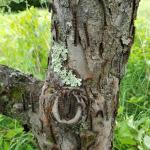
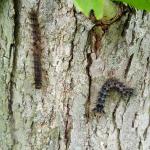 Gypsy Moth:(Lymantria dispar) host plants include but are certainly not limited to oak (favored), maple, birch, poplar, elm, witch hazel, and many others. Gypsy moth mortality is again occurring in Massachusetts! Population densities are much lower this year compared to 2017, but similar to what happened that year, a quick and dramatic mortality event occurred the end of last week and into early this week. We know insects don't follow calendar dates, but from records from previous years, Entomophaga maimaiga (a fungal pathogen specific to gypsy moth) also struck the gypsy moth caterpillar population over the weekend of 6/24 and 6/25/2017. So it would appear we are "right on schedule" in 2019! Of course, the NPV virus that also kills gypsy moth caterpillars could be active at this time as well. Field identification of the cause of death is not always 100% accurate, but in general gypsy moth caterpillars killed by Entomophaga maimaiga hang vertically from trees with their legs extended and stiff. They may also be desiccated. When the NPV virus kills the caterpillar, in general, they hang from the tree in an inverted V-shape and are still “juicy”. Caterpillar mortality has been reported from Millis, MA (6/22/19), Leicester, MA (6/23/19), Amherst, MA (6/25/19), and Belchertown, MA (6/25/19). Dr. Joseph Elkinton reports that he and his lab team collected gypsy moth caterpillars from their research sites in Massachusetts on Monday (6/24/19) and by Tuesday, 70% of the caterpillars had died. At the end of last week, they recorded 50% mortality at the same research locations. Clearly, an epizootic has again occurred in the gypsy moth population. Given that gypsy moth caterpillars were at a much lower density this year, this mortality event could be the final straw that drives them to low, non-pest densities that we hopefully will enjoy for at least the next few years (possibly decades if history is any indicator) in most locations in MA!
Gypsy Moth:(Lymantria dispar) host plants include but are certainly not limited to oak (favored), maple, birch, poplar, elm, witch hazel, and many others. Gypsy moth mortality is again occurring in Massachusetts! Population densities are much lower this year compared to 2017, but similar to what happened that year, a quick and dramatic mortality event occurred the end of last week and into early this week. We know insects don't follow calendar dates, but from records from previous years, Entomophaga maimaiga (a fungal pathogen specific to gypsy moth) also struck the gypsy moth caterpillar population over the weekend of 6/24 and 6/25/2017. So it would appear we are "right on schedule" in 2019! Of course, the NPV virus that also kills gypsy moth caterpillars could be active at this time as well. Field identification of the cause of death is not always 100% accurate, but in general gypsy moth caterpillars killed by Entomophaga maimaiga hang vertically from trees with their legs extended and stiff. They may also be desiccated. When the NPV virus kills the caterpillar, in general, they hang from the tree in an inverted V-shape and are still “juicy”. Caterpillar mortality has been reported from Millis, MA (6/22/19), Leicester, MA (6/23/19), Amherst, MA (6/25/19), and Belchertown, MA (6/25/19). Dr. Joseph Elkinton reports that he and his lab team collected gypsy moth caterpillars from their research sites in Massachusetts on Monday (6/24/19) and by Tuesday, 70% of the caterpillars had died. At the end of last week, they recorded 50% mortality at the same research locations. Clearly, an epizootic has again occurred in the gypsy moth population. Given that gypsy moth caterpillars were at a much lower density this year, this mortality event could be the final straw that drives them to low, non-pest densities that we hopefully will enjoy for at least the next few years (possibly decades if history is any indicator) in most locations in MA!
Gypsy moth caterpillars typically begin to pupate at this time in Massachusetts, if they survive. Pupation should be observed and adults may begin to appear within the next week or so. Once pupation occurs, the insect will no longer feed for the current season, and management is no longer necessary or feasible. Adult moths do not feed. The adult male gypsy moth is brown with black markings and highly feathered antennae. Adult male gypsy moths can fly. The adult female gypsy moth is white with black markings and straight, threadlike, black antennae. In Massachusetts, female gypsy moths do not fly (in other parts of the world, certain types of gypsy moths have females capable of flight). After the adults mate, the female moths will begin to lay the egg masses (tan/brown and spongy) which will overwinter. But because of the pathogens specific to gypsy moth mentioned above, we can hope that adults and egg masses will be few and far between!
- Asian Longhorned Beetle: (Anoplophora glabripennis, ALB) Look for signs of an ALB infestation which include perfectly round exit holes (about the size of a dime), shallow oval or round scars in the bark where a female has chewed an egg site, or sawdust-like frass (excrement) on the ground nearby host trees or caught in between branches. Be advised that other, native insects may create perfectly round exit holes or sawdust-like frass, which can be confused with signs of ALB activity.
The regulated area for Asian longhorned beetle is 110 miles2 encompassing Worcester, Shrewsbury, Boylston, West Boylston, and parts of Holden and Auburn. If you believe you have seen damage caused by this insect, such as exit holes or egg sites, on susceptible host trees like maple, please call the Asian Longhorned Beetle Eradication Program office in Worcester, MA at 508-852-8090 or toll free at 1-866-702-9938.
To report an Asian longhorned beetle find online or compare it to common insect look-alikes, visit: http://massnrc.org/pests/albreport.aspx or https://www.aphis.usda.gov/pests-diseases/alb/report .
- White Spotted Pine Sawyer (WSPS): Monochamus scutellatus adults can emerge now throughout July. This is a native insect in Massachusetts and is usually not a pest. Larvae develop in weakened or recently dead conifers, particularly eastern white pine (Pinus strobus). However, the white spotted pine sawyer looks very similar to the invasive Asian Longhorned Beetle, Anoplophora glabripennis, ALB. ALB adults do not emerge in Massachusetts until July and August. Beginning in July, look for the key difference between WSPS and ALB adults, which is a white spot in the top center of the wing covers (the scutellum) on the back of the beetle. White spotted pine sawyer will have this white spot, whereas Asian longhorned beetle will not. Both insects can have other white spots on the rest of their wing covers; however, the difference in the color of the scutellum is a key characteristic. If you find a suspicious insect, report it:http://massnrc.org/pests/albreport.aspx or https://www.aphis.usda.gov/pests-diseases/alb/report .
- Cottony Taxus Scale: Pulvinaria floccifera, also referred to as the cottony camellia scale, utilizes such hosts as Taxus, Camellia, holly, Hydrangea, Japanese maple, Euonymus, Magnolia, and jasmine, among others. Females have laid the long, narrow, white and fluted egg sac that makes them much more noticeable. Eggs will hatch over an extended period of 6 weeks and crawlers may be treated between 802-1388 GDD’s. This insect can cause the host to appear off-color. They also produce honeydew which promotes sooty mold growth. Dieback is not common with this insect. Target the underside of the foliage. Horticultural oil, neem oil, and insecticidal soaps may be used to manage these soft scales. Reduced risk options help preserve natural enemies.
- Deer Tick/Blacklegged Tick: Check out the archived FREE TickTalk with TickReport webinars available here:https://ag.umass.edu/landscape/education-events/webinars . The next live webinar will be held on October 9, 2019 with Dr. Stephen Rich of the UMass Laboratory of Medical Zoology. Previous webinars including information about deer ticks and associated diseases, American dog ticks and lone star ticks and associated diseases, ticks and personal protection, and updates from the Laboratory of Medical Zoology are archived at the link above.
Deer tick (Ixodes scapularis) nymphs (immatures) are active at this time, and may be encountered now through August. For images of all deer tick life stages, along with an outline of the diseases they carry, visit: http://www.tickencounter.org/tick_identification/deer_tick .
Anyone working in the yard and garden should be aware that there is the potential to encounter deer ticks. The deer tick or blacklegged tick can transmit Lyme disease, human babesiosis, human anaplasmosis, and other diseases. Preventative activities, such as daily tick checks, wearing appropriate clothing, and permethrin treatments for clothing (according to label instructions) can aid in reducing the risk that a tick will become attached to your body. If a tick cannot attach and feed, it will not transmit disease. For more information about personal protective measures, visit: http://www.tickencounter.org/prevention/protect_yourself . For a quick overview of skin repellents available to protect yourself from ticks, visit “Tickology: Skin Repellents” by Larry Dapsis of Cape Cod Cooperative Extension:https://bit.ly/2J8IJBl .
Have you just removed an attached tick from yourself or a loved one with a pair of tweezers? If so, consider sending the tick to the UMass Laboratory of Medical Zoology to be tested for disease causing pathogens. To submit a tick to be tested, visit: https://www.tickreport.com/ and click on the blue “Order a TickReport” button. Results are typically available within 3 business days, or less. By the time you make an appointment with your physician following the tick attachment, you may have the results back from TickReport to bring to your physician to aid in a conversation about risk.
The UMass Laboratory of Medical Zoology does not give medical advice, nor are the results of their tests diagnostic of human disease. Transmission of a pathogen from the tick to you is dependent upon how long the tick had been feeding, and each pathogen has its own transmission time. TickReport is an excellent measure of exposure risk for the tick (or ticks) that you send in to be tested. Feel free to print out and share your TickReport with your healthcare provider.
- Elongate Hemlock Scale: Fiorinia externa is found on eastern, Carolina, and Japanese hemlock, as well as yew, spruce, and fir. Overlap of many developmental stages at any given time can be observed. Treatments for the crawler, or mobile, stage of this insect may be made in late May through mid-June, or between 360-700 GDD’s, base 50°F.
- Emerald Ash Borer: (Agrilus planipennis, EAB) Three additional communities have had emerald ash borer confirmed by the Massachusetts Department of Conservation and Recreation. This brings the 2019 count to 29 new communities added to the list of known areas where this insect occurs in the state. A map of these locations and others previously known across the state may be found here: https://ag.umass.edu/fact-sheets/emerald-ash-borer .
This wood-boring beetle readily attacks ash (Fraxinus spp.) including white, green, and black ash and has also been found developing in white fringe tree (Chionanthus virginicus) and has been reported in cultivated olive (Olea europaea). Signs of an EAB infested tree may include D-shaped exit holes in the bark (from adult emergence), “blonding” or lighter coloration of the ash bark from woodpecker feeding (chipping away of the bark as they search for larvae beneath), and serpentine galleries visible through splits in the bark, from larval feeding beneath. Positive identification of an EAB-infested tree may not be possible with these signs individually on their own.
For further information about this insect, please visit: https://ag.umass.edu/fact-sheets/emerald-ash-borer . If you believe you have located EAB-infested ash trees, particularly in an area of Massachusetts not identified on the map provided, please report here: http://massnrc.org/pests/pestreports.htm .

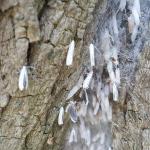
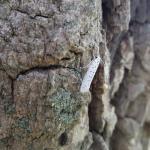 Euonymus Caterpillar: Yponomeuta cagnagella is of European origin and widespread in distribution throughout Europe. It was first reported in North America in Ontario in 1967. Adult moths have emerged at a location in Amherst, MA being monitored as of 6/25/19. The adult moth of this species is sometimes referred to as the “spindle ermine moth”. They are small and entirely white except for black spots adorning their wings. Antennae are white and long and threadlike. Adult moths no longer feed. Females will, over the next few weeks, lay their eggs. Eggs are reported to hatch in mid-August and tiny larvae overwinter beneath their eggshell-like covering. (No further feeding by this insect will occur until next year.)
Euonymus Caterpillar: Yponomeuta cagnagella is of European origin and widespread in distribution throughout Europe. It was first reported in North America in Ontario in 1967. Adult moths have emerged at a location in Amherst, MA being monitored as of 6/25/19. The adult moth of this species is sometimes referred to as the “spindle ermine moth”. They are small and entirely white except for black spots adorning their wings. Antennae are white and long and threadlike. Adult moths no longer feed. Females will, over the next few weeks, lay their eggs. Eggs are reported to hatch in mid-August and tiny larvae overwinter beneath their eggshell-like covering. (No further feeding by this insect will occur until next year.)
The euonymus caterpillars (larvae) feed in groups and envelop the foliage of the host plant in webs as they feed. Hosts include: Euonymus europaeus (tree form), E. kiautschovicus, E. alatus, and E. japonicus. Mature caterpillars are just under an inch in length, creamy yellow-gray in color with black spots and a black head capsule. By late June, these larvae pupate in white, oval-shaped cocoons which are typically oriented together vertically either on host plants or non-hosts in the area. Cocoons can be found in cracks and crevices, or webbed together leaves. The adult moth emerges in late June in most locations. The adult female secretes a gummy substance over her eggs which will harden, making them even more difficult to see. Eggs hatch by mid-August, at which time the tiny larvae prepare to overwinter beneath their eggshell-like covering. These larvae are inactive until the following year, when caterpillars group together to feed on newly emerging leaves, creating a mess of webs as they feed. There is one generation per year. Plants may be partially or entirely defoliated. Management of young, actively feeding caterpillars with Bacillus thuringiensis is possible if deemed necessary, however many species of Euonymus are considered invasive themselves.
- Fall Webworm: Hyphantria cunea is native to North America and Mexico. It is now considered a world-wide pest, as it has spread throughout much of Europe and Asia. (For example, it was introduced accidentally into Hungary from North America in the 1940’s.) Hosts include nearly all shade, fruit, and ornamental trees except conifers. In the USA, at least 88 species of trees are hosts for these insects, while in Europe at least 230 species are impacted. In the past history of this pest, it was once thought that the fall webworm was a two-species complex. It is now thought that H. cunea has two color morphs – one black headed and one red headed. These two color forms differ not only in the coloration of the caterpillars and the adults, but also in their behaviors. Caterpillars may go through at least 11 molts, each stage occurring within a silken web they produce over the host. When alarmed, all caterpillars in the group will move in unison in jerking motions that may be a mechanism for self-defense. Depending upon the location and climate, 1-4 generations of fall webworm can occur per year. Fall webworm adult moths lay eggs on the underside of the leaves of host plants in the spring. These eggs hatch in late June or early July depending on climate. Young larvae feed together in groups on the undersides of leaves, first skeletonizing the leaf and then enveloping other leaves and eventually entire branches within their webs. Webs are typically found on the terminal ends of branches. All caterpillar activity occurs within this tent, which becomes filled with leaf fragments, cast skins, and frass. Fully grown larvae then wander from the webs and pupate in protected areas such as the leaf litter where they will remain for the winter. Adult fall webworm moths emerge the following spring/early summer to start the cycle over again. 50+ species of parasites and 36+ species of predators are known to attack fall webworm in North America. Fall webworms typically do not cause extensive damage to their hosts. Nests may be an aesthetic issue for some. If in reach, small fall webworm webs may be pruned out of trees and shrubs and destroyed. Do not set fire to H. cunea webs when they are still attached to the host plant.
- Imported Willow Leaf Beetle: Plagiodera versicolora adult beetles overwinter near susceptible hosts. A few adult imported willow leaf beetles were seen feeding on willow foliage in Chesterfield, MA on 5/11/19 and no mating or egg laying was seen at the time.By 5/22/19, it was very easy to spot adult imported willow leaf beetles feeding and mating, as well as the damage they cause to the leaves. Egg laying was also observed on 5/22/19. On 5/29/19, feeding adult beetles and clusters of eggs were still observed. No larvae were yet seen at this particular location at that time. However, by 6/2/19, clusters of eggs hatched and tiny, feeding imported willow leaf beetle larvae could be seen. These yellow-ish larvae skeletonize the leaf in groups. Larvae were observed feeding on Japanese pussy willow and corkscrew willow on 6/12/19 in Boylston, MA. Extensive skeletonization of leaves was occurring on the corkscrew willow, in particular, at this location. Larvae are slug-like and bluish-green to yellow in color. They will feed in clusters and skeletonize the leaves. Most plants can tolerate the feeding from this insect, and foliage will appear brown. Repeated yearly feeding can be an issue, in which case management of the young larvae may be necessary. Take care with treatment in areas near water.
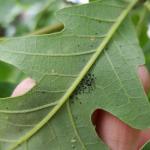 Lace Bugs: Corythucha spp. and Stephanitis spp. lace bugs are active. Corythucha spp. utilize many hosts such as: hawthorn, cotoneaster, Amelanchier, quince, Pyracantha, various oaks, birch, maple, mountain ash, sycamore, hackberry, elm, walnut, butternut, basswood, etc. Corythucha spp. lace bug eggs (tiny and black) were seen on bur oak on 6/25/2019 in Amherst, MA. Egg are so small, they may look like fungal spores without magnification. Stephanitis spp. lacebugs such as S. pyriodes can cause severe injury to azalea foliage. S. rhododendri can be common on Rhododendron and mountain laurel. S. takeyai has been found developing on Japanese Andromeda, Leucothoe, Styrax, and willow. Stephanitis spp.lace bug activity should be monitored through September. Before populations become too large, treat with a summer rate horticultural oil spray as needed. Be sure to target the undersides of the foliage in order to get proper coverage of the insects. Systemic insecticides applied after bloom have been reported as effective. Be aware of the implications this may have on pollinators attracted to these flowering plants when making management decisions. Certain azalea and Andromeda cultivars may be less preferred by lace bugs.
Lace Bugs: Corythucha spp. and Stephanitis spp. lace bugs are active. Corythucha spp. utilize many hosts such as: hawthorn, cotoneaster, Amelanchier, quince, Pyracantha, various oaks, birch, maple, mountain ash, sycamore, hackberry, elm, walnut, butternut, basswood, etc. Corythucha spp. lace bug eggs (tiny and black) were seen on bur oak on 6/25/2019 in Amherst, MA. Egg are so small, they may look like fungal spores without magnification. Stephanitis spp. lacebugs such as S. pyriodes can cause severe injury to azalea foliage. S. rhododendri can be common on Rhododendron and mountain laurel. S. takeyai has been found developing on Japanese Andromeda, Leucothoe, Styrax, and willow. Stephanitis spp.lace bug activity should be monitored through September. Before populations become too large, treat with a summer rate horticultural oil spray as needed. Be sure to target the undersides of the foliage in order to get proper coverage of the insects. Systemic insecticides applied after bloom have been reported as effective. Be aware of the implications this may have on pollinators attracted to these flowering plants when making management decisions. Certain azalea and Andromeda cultivars may be less preferred by lace bugs.
- Lily Leaf Beetle: Lilioceris lilii adults overwintered in sheltered places. Although adult beetles were not seen during the chilly weather on 5/13/19 in Amherst, MA, previously laid eggs were found on host plant foliage in this location. As of 5/21/19, egg hatch had occurred and larvae of various sizes could be seen feeding on foliage in groups. Smaller larvae skeletonize leaves, whereas larger larvae can eat the entire leaf.By 5/30/19, large lily leaf beetle larvae were observed eating entire leaves. Conditions were also favorable to see adults mating, and eggs could also still be found at this location on 5/30. On 6/3/19, adult lily leaf beetles, eggs, and larvae of various sizes were still seen on host plants. Susceptible hosts include Lilium spp. (Turk’s cap, tiger, Easter, Asiatic, and Oriental lilies) and Fritillaria spp. (Note: daylilies are not hosts.) Typically, in May, mating will occur and each female will begin to lay 250-450 eggs in neat rows on the underside of the foliage. If there are only a few plants in the garden, hand picking and destroying overwintering adults can help reduce local garden-level populations.
- Spotted Lanternfly: (Lycorma delicatula, SLF) is not known to occur in Massachusetts landscapes (no established populations are known in MA at this time). However, officials with the Massachusetts Department of Agricultural Resources (MDAR) urged residents to check plants for spotted lanternfly. On February 21, 2019 MDAR announced the discovery of a single dead spotted lanternfly adult at a private residence in Boston. As a result of this discovery, officials asked the public to check potted plants they purchase and report any suspicious insects. MDAR reports that this particular individual appeared to have been unintentionally transported this past December in a shipment of poinsettia plants originating from Pennsylvania. Officials also report that there is currently no evidence that this pest has become established in MA. For more information about this finding, please visit the MA Department of Agricultural Resources press release:https://www.mass.gov/news/state-agricultural-officials-urge-residents-to-check-plants-for-spotted-lanternfly .
This insect is a member of the Order Hemiptera (true bugs, cicadas, hoppers, aphids, and others) and the Family Fulgoridae, also known as planthoppers. The spotted lanternfly is a non-native species first detected in the United States in Berks County, Pennsylvania and confirmed on September 22, 2014.
The spotted lanternfly is considered native to China, India, and Vietnam. It has been introduced as a non-native insect to South Korea and Japan, prior to its detection in the United States. In South Korea, it is considered invasive and a pest of grapes and peaches. The spotted lanternfly has been reported from over 70 species of plants, including the following: tree of heaven (Ailanthus altissima) (preferred host), apple (Malus spp.), plum, cherry, peach, apricot (Prunus spp.), grape (Vitis spp.), pine (Pinus spp.), pignut hickory (Carya glabra), Sassafras (Sassafras albidum), serviceberry (Amelanchier spp.), slippery elm (Ulmus rubra), tulip poplar (Liriodendron tulipifera), white ash (Fraxinus americana), willow (Salix spp.), American beech (Fagus grandifolia), American linden (Tilia americana), American sycamore (Platanus occidentalis), big-toothed aspen (Populus grandidentata), black birch (Betula lenta), black cherry (Prunus serotina), black gum (Nyssa sylvatica), black walnut (Juglans nigra), dogwood (Cornus spp.), Japanese snowbell (Styrax japonicus), maple (Acer spp.), oak (Quercus spp.), and paper birch (Betula papyrifera).
The adults and immatures of this species damage host plants by feeding on sap from stems, leaves, and the trunks of trees. In the springtime in Pennsylvania (late April - mid-May) nymphs (immatures) are found on smaller plants and vines and new growth of trees and shrubs. Third and fourth instar nymphs migrate to the tree of heaven and are observed feeding on trunks and branches. Trees may be found with sap weeping from the wounds caused by the insect’s feeding. The sugary secretions (excrement) created by this insect may coat the host plant, later leading to the growth of sooty mold. Insects such as wasps, hornets, bees, and ants may also be attracted to the sugary waste created by the lanternflies, or sap weeping from open wounds in the host plant. Host plants have been described as giving off a fermented odor when this insect is present.
Adults are present by the middle of July in Pennsylvania and begin laying eggs by late September and continue laying eggs through late November and even early December in that state. Adults may be found on the trunks of trees such as the tree of heaven or other host plants growing in close proximity to them. Egg masses of this insect are gray in color and, in some ways, look similar to gypsy moth egg masses.
Host plants, bricks, stone, lawn furniture, recreational vehicles, and other smooth surfaces can be inspected for egg masses. Egg masses laid on outdoor residential items such as those listed above may pose the greatest threat for spreading this insect via human aided movement.
For more information about the spotted lanternfly, visit this fact sheet: https://ag.umass.edu/landscape/fact-sheets/spotted-lanternfly .
- Taxus Mealybug: Dysmicoccus wistariae was spotted on Taxus in Amherst on 5/30/19, 6/3/19, and again on 6/19/19. This insect will produce honeydew and lead to sooty mold growth, yellowing of needles, and sparsely foliated plants. Eventual dieback may be possible. This species is commonly associated with Taxus in New England, but can be occasionally found on dogwood, Rhododendron, Prunus spp., maple, Andromeda, and crabapple. These mealybugs are found on stems and branches and particularly like to congregate at branch crotches. Management may be targeted between 246-618 GDD’s. Horticultural oil and neem oil may be used according to label instructions.
- Viburnum Leaf Beetle: Pyrrhalta viburni is a beetle in the family Chrysomelidae that is native to Europe, but was found in Massachusetts in 2004. In Amherst, MA on 6/17/19, plants being monitored for the presence of this pest were devoid of feeding larvae. When observed again on 6/26/19, no larvae or adult Viburnum leaf beetle were seen at this location. This is the time of year that Viburnum leaf beetle larvae, when they are approximately 10-11 mm. long, crawl down the shrub, enter the soil, and pupate. Once this occurs, feeding stops (pauses) until the adult beetles emerge in early July. At that time, adult beetles will resume feeding, mate, and the females will lay their eggs in pits they chew at the ends of twigs. Eggs overwinter. Adults may also migrate to previously not yet infested plants. This beetle feeds exclusively on many different species of Viburnum, which includes, but is not limited to, susceptible plants such as V. dentatum, V. nudum, V. opulus, V. propinquum, and V. rafinesquianum. Larvae may be treated with a product containing spinosad. Some Viburnum have been observed to have varying levels of resistance to this insect, including but not limited to V. bodnantense, V. carlesii, V. davidii, V. plicatum, V. rhytidophyllum, V. setigerum, and V. sieboldii. More information about Viburnum leaf beetle may be found at http://www.hort.cornell.edu/vlb/ .
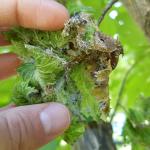 Woolly Apple Aphid: Eriosoma lanigerum may be found on apple, crabapple, hawthorn, mountain-ash, Pyracantha, and elm hosts. The primary (winter) host is elm, on which aphids infest emerging spring leaves, causing leaves to curl or close into stunted, rosette-like clusters found at twig tips. Any such damage seen now was caused earlier this season. Following a few generations on elm, the aphids will develop into a winged form, which will disperse and seek out apple and crabapple. Rosette-like clusters of leaves, caused earlier this year by the woolly apple aphid on elm, are now vacant at a location in Amherst, MA as observed on 6/26/19. Winged individuals have dispersed. Multiple generations will occur on these alternate hosts in the summer and by the fall, a winged form will return to elm and mated females will lay eggs near elm buds.
Woolly Apple Aphid: Eriosoma lanigerum may be found on apple, crabapple, hawthorn, mountain-ash, Pyracantha, and elm hosts. The primary (winter) host is elm, on which aphids infest emerging spring leaves, causing leaves to curl or close into stunted, rosette-like clusters found at twig tips. Any such damage seen now was caused earlier this season. Following a few generations on elm, the aphids will develop into a winged form, which will disperse and seek out apple and crabapple. Rosette-like clusters of leaves, caused earlier this year by the woolly apple aphid on elm, are now vacant at a location in Amherst, MA as observed on 6/26/19. Winged individuals have dispersed. Multiple generations will occur on these alternate hosts in the summer and by the fall, a winged form will return to elm and mated females will lay eggs near elm buds.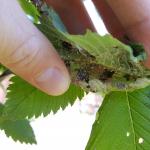 Woolly Elm Aphid: Eriosoma americanum females lay a single egg in the cracks and crevices of elm bark, where the egg overwinters. Eggs hatch on elm in the spring as leaves are unfolding. A young, wingless female hatched from the egg feeds on the underside of leaf tissue. This female aphid matures and gives birth to 200 young, all females, without mating. These aphids feed, and the elm leaf curls around them and protects them. By the end of June, winged migrants mature and find serviceberry hosts. As observed on 6/26/2019, elm leaves previously curled by the woolly elm aphid are “empty” (winged aphids have left the elm in search of serviceberry). Another set of females is produced. These new females crawl to and begin feeding on the roots of serviceberry. Multiple generations occur on the roots of serviceberry through the summer.
Woolly Elm Aphid: Eriosoma americanum females lay a single egg in the cracks and crevices of elm bark, where the egg overwinters. Eggs hatch on elm in the spring as leaves are unfolding. A young, wingless female hatched from the egg feeds on the underside of leaf tissue. This female aphid matures and gives birth to 200 young, all females, without mating. These aphids feed, and the elm leaf curls around them and protects them. By the end of June, winged migrants mature and find serviceberry hosts. As observed on 6/26/2019, elm leaves previously curled by the woolly elm aphid are “empty” (winged aphids have left the elm in search of serviceberry). Another set of females is produced. These new females crawl to and begin feeding on the roots of serviceberry. Multiple generations occur on the roots of serviceberry through the summer.
Concerned that you may have found an invasive insect or suspicious damage caused by one? Need to report a pest sighting? If so, please visit the Massachusetts Introduced Pests Outreach Project: http://massnrc.org/pests/pestreports.htm .
A note about Tick Awareness: deer ticks (Ixodes scapularis), the American dog tick (Dermacentor variabilis), and the lone star tick (Amblyomma americanum) are all found throughout Massachusetts. Each can carry their own complement of diseases. Anyone working in tick habitats (wood-line areas, forested areas, and landscaped areas with ground cover) should check themselves regularly for ticks while practicing preventative measures. Have a tick and need it tested? Visit the web page of the UMass Laboratory of Medical Zoology (https://www.tickreport.com/ ) and click on the blue Order a TickReport button for more information.
Reported by Tawny Simisky, Extension Entomologist, UMass Extension Landscape, Nursery, & Urban Forestry Program
Additional Resources
To receive immediate notification when the next Landscape Message update is posted, be sure to join our e-mail list and follow us on Facebook and Twitter.
For a complete listing of upcoming events, see our Upcoming Educational Events page.
For commercial growers of greenhouse crops and flowers - Check out UMass Extension's Greenhouse Update website
For professional turf managers - Check out Turf Management Updates
For home gardeners and garden retailers - Check out home lawn and garden resources. UMass Extension also has a Twitter feed that provides timely, daily gardening tips, sunrise and sunset times to home gardeners, see https://twitter.com/UMassGardenClip
Diagnostic Services
A UMass Laboratory Diagnoses Landscape and Turf Problems - The UMass Extension Plant Diagnostic Lab is available to serve commercial landscape contractors, turf managers, arborists, nurseries and other green industry professionals. It provides woody plant and turf disease analysis, woody plant and turf insect identification, turfgrass identification, weed identification, and offers a report of pest management strategies that are research based, economically sound and environmentally appropriate for the situation. Accurate diagnosis for a turf or landscape problem can often eliminate or reduce the need for pesticide use. For sampling procedures, detailed submission instructions and a list of fees, see Plant Diagnostics Laboratory
Soil and Plant Nutrient Testing - The University of Massachusetts Soil and Plant Nutrient Testing Laboratory is located on the campus of The University of Massachusetts at Amherst. Testing services are available to all. The function of the Soil and Plant Nutrient Testing Laboratory is to provide test results and recommendations that lead to the wise and economical use of soils and soil amendments. For complete information, visit the UMass Soil and Plant Nutrient Testing Laboratory web site. Alternatively, call the lab at (413) 545-2311.
Ticks are active at this time! Remember to take appropriate precautions when working and playing outdoors, and conduct daily tick checks. UMass tests ticks for the presence of Lyme disease and other disease pathogens. Learn more.

